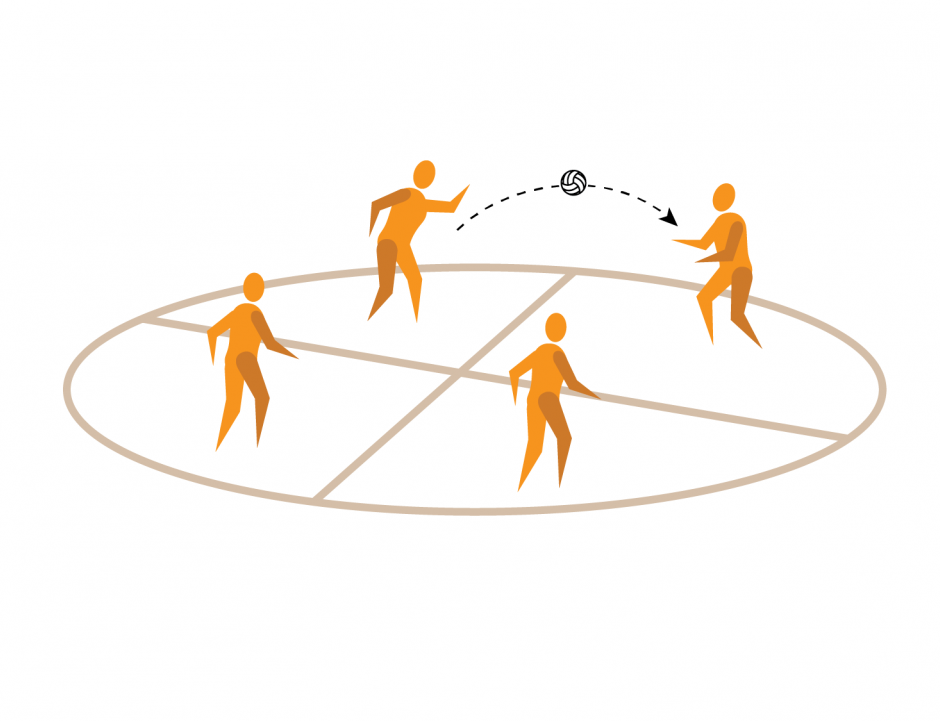TGfU Category: Net/Wall Games
Locations: gymnasium, outdoor space (e.g., field, tarmac)
Game/Sport Connections
Net/Wall games are activities in which players send an object toward a court or target area that an opponent is defending. The aim is to cause the object to land in the target area while making it difficult for the opponent to return the object. By playing these games, participants develop skills and tactics to play other net/wall games or games that require the application of similar skills, concepts, and strategies (e.g., sitting volleyball, tennis, badminton, squash, racquet ball, volleyball, Sepak Takraw, wheelchair tennis).
Activity Overview
Participants learn about and practise sending and receiving an object while covering a designated area.
Key Movement Skills, Concepts, and Strategies
Throughout the activity, consider highlighting the following skills, concepts, and strategies to help participants send and receive an object while effectively covering an area. Note that this is not an exhaustive list and further learning opportunities may arise during the task.
Movement Skills and Concepts
- Manipulation skills and effort awareness: applying a controlled force to send the object to another participant within a designated area (e.g., being able to control the force used when sending the object to another participant so the participant is successful at receiving it).
- Relationship and spatial awareness: knowing how to move to be successful at sending and receiving the object while playing with other participants (e.g., moving the appropriate body parts to send the object to another participant within proximity).
Movement Strategies
Tactical awareness: developing an understanding of the principles of play (e.g., knowing where and how to send the object into another participant’s quadrant so the other participant is successful at receiving it).
Considerations
- Incorporate some or all of the variations listed in the “Variations” section while planning the activity. This will help to best meet the diverse backgrounds, identities, needs, and interests of participants and maximize the fun, inclusion, participation, and success of everyone.
- To elevate participant voice and choice, periodically pause the activity and share the variations with participants. Ask them to determine how they would like to change the activity to maximize the fun, inclusion, meaningful participation, and success for everyone. Encourage participants to add any variations of their own.
Equipment
- 1 ball to send per group (e.g., beach ball, soft-skinned ball, volleyball)
- 5 cones per group
Safety
- Inspect the equipment and activity area to identify and remove hazards. Check that the activity surface provides sufficient traction.
- Establish the boundaries for the designated playing area at a safe distance from walls and obstacles. Share the boundaries with participants.
- Review the safety rules and activity instructions with participants prior to the activity.
- Instruct participants to be aware of their surroundings, including the locations of other participants during play.
How to Play
- Divide participants into groups of 4.
- Assign groups to a designated playing area.
- Groups use 4 cones to create a quadrant in their playing area and place 1 cone in the middle to mark the centre of the quadrant. Participants may increase or decrease the size of the playing area at any point during play, being mindful of other participants’ designated playing areas.
- While staying within their quadrants, participants send the ball back and forth to their group members (e.g., sending underhand, striking, volleying with hands or feet).
- Participants keep the ball up as long as possible or send it as many times in a row without it dropping or going out of bounds. Participants can also decide if bounces are allowed.
- When the ball is dropped or goes out of bounds, participants rotate quadrants and start again. Participants move in a clockwise direction.
- After a period of play, provide participants with some or all of the variations. Ask them to decide how they might change the game to enhance their fun, challenge, and success. Encourage participants to add any variations of their own.
- Consider having groups share their variations and select another variation to try with their group.
Image: Visual Depiction of the Activity Instructions

Pause for Learning
Throughout the activity, ask open-ended questions to help participants refine their movement skills, strategies, and tactical solutions. Examples include:
- How do you send the ball to increase your teammates’ chances of successfully receiving the pass?
- How do you communicate with other members in your group to be more successful at passing?
- How do you position your body to be ready to receive the ball?
- Which games or sports have you played or know about that use similar rules and strategies to the ones used in this game?
Variations
- Change the way participants send the ball (e.g., bumping, overhand toss, using the non-dominant hand).
- Allow the ball to bounce once before sending it to another group member.
- Change the sending object (e.g., beanbag, rubber chicken, disc) and eliminate the bounce.
- Increase or decrease the size of the quadrant.
- Have participants kick the ball to each other while keeping the ball in contact with the ground.


